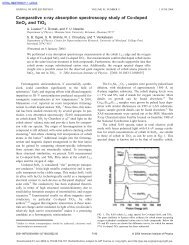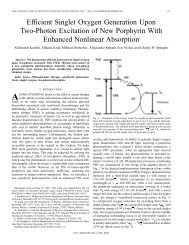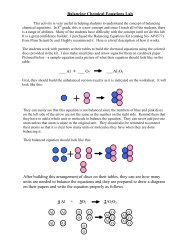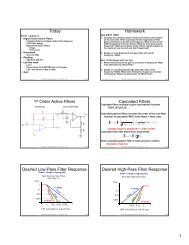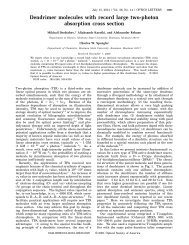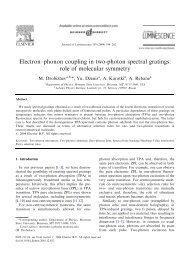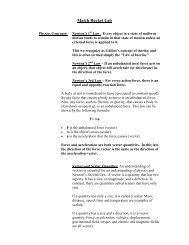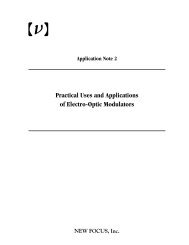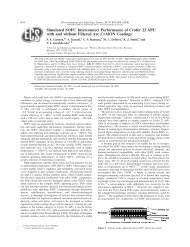Defects in inorganic photorefractive materials and their investigations
Defects in inorganic photorefractive materials and their investigations
Defects in inorganic photorefractive materials and their investigations
Create successful ePaper yourself
Turn your PDF publications into a flip-book with our unique Google optimized e-Paper software.
12 B. Briat et al.<br />
the conduction b<strong>and</strong>. This transfer leads to comparatively high photovoltaic<br />
currents [37, 38].<br />
As has been stated, the EPR of the Nb Li defect <strong>and</strong> its optical absorption<br />
can be observed with a reduced crystal, if it is illum<strong>in</strong>ated. The reduced<br />
state of congruent LN is characterized by an absorption b<strong>and</strong> peaked<br />
near 2.5 eV (Fig. 5c) <strong>and</strong> a diamagnetic groundstate. Optically pump<strong>in</strong>g with<br />
light-energies <strong>in</strong> the range of this b<strong>and</strong> creates the paramagnetic state Nb 4+<br />
Li<br />
<strong>and</strong> the correspond<strong>in</strong>g absorption (Fig. 5b). Because of its diamagnetism, the<br />
groundstate of the reduced crystal cannot furnish direct EPR <strong>in</strong>formation on<br />
the defect caus<strong>in</strong>g its optical absorption. On the basis of various circumstantial<br />
evidences [24] we have assigned the absorption (Fig. 5c) to a bipolaron,<br />
propos<strong>in</strong>g as a model system two electrons with antiparallel sp<strong>in</strong>s at two<br />
neighbor<strong>in</strong>g Nb ions, Nb 4+<br />
Li<br />
-Nb 4+<br />
Nb<br />
(Fig. 6c); here one Nb ion replaces Li, <strong>and</strong><br />
the other one is part of the regular lattice. On account of the high density of<br />
Nb Li <strong>in</strong> Li deficient LN - one <strong>in</strong> each fiftieth unit cell - there are many such<br />
preformed pairs of Nb Li <strong>and</strong> Nb Nb ; both Nb positions are dist<strong>in</strong>guished only<br />
by the slightly different Madelung potentials active at the respective sites.<br />
The model has to expla<strong>in</strong> that two electrons jo<strong>in</strong>tly occupy<strong>in</strong>g both Nb sites<br />
are more stable than if they were distributed over two separated <strong>and</strong> isolated<br />
Nb Li ions, because light energy has to be fed <strong>in</strong>to the system to create Nb 4+<br />
Li<br />
from the diamagnetic precursor. S<strong>in</strong>ce this diamagnetic state is present <strong>in</strong> the<br />
groundstate of a reduced crystal <strong>in</strong> spite of the Coulomb <strong>in</strong>teraction between<br />
the two Nb 4+ electrons (Fig. 6c), this repulsion must be overcompensated by<br />
<strong>their</strong> jo<strong>in</strong>t lattice distortion. Such a situation is typical for a bipolaron. It is<br />
most likely that both partners relax towards each other (double arrows <strong>in</strong> Fig.<br />
6c), thereby lower<strong>in</strong>g the electronic part of the total energy by strengthen<strong>in</strong>g<br />
the covalent bond <strong>in</strong> the pair; this is quite similar to the dynamics of a H 2<br />
molecule. The creation of isolated Nb 4+<br />
Li<br />
by illum<strong>in</strong>ation <strong>in</strong>to the 2.5 eV b<strong>and</strong><br />
has the effect that the bipolaron is optically dissociated; the electron ionized<br />
from Nb 4+<br />
Nb will be trapped rather rapidly at a further empty Nb Li defect.<br />
This dissociated state is metastable at low temperatures. Start<strong>in</strong>g near 200 K,<br />
thermal dissociation of the bipolarons beg<strong>in</strong>s, <strong>and</strong> the 2.5 eV b<strong>and</strong> decreases<br />
while the 1.6 eV absorption rises (Fig. 5b). For the enthalpies <strong>in</strong>volved <strong>in</strong> these<br />
processes see Ref. [25]. At room temperature a sizeable portion of the 2.5 eV<br />
b<strong>and</strong> still is present [24] <strong>in</strong> thermal equilibrium. At this temperature the described<br />
optical switch<strong>in</strong>g process - between b<strong>and</strong>s c <strong>and</strong> b <strong>in</strong> Fig. 5 - could<br />
thus be utilized for optically gated holographic record<strong>in</strong>g [39]: Illum<strong>in</strong>ation<br />
with energies <strong>in</strong> the range of the the 2.5 eV b<strong>and</strong> sensitizes a reduced crystal<br />
for <strong>photorefractive</strong> operation at the lower energies correspond<strong>in</strong>g to the 1.6 eV<br />
b<strong>and</strong>.<br />
It has sometimes been postulated [34, 40] that the defect responsible for<br />
the 2.5 eV b<strong>and</strong> rather is an oxygen vacancy, filled with two diamagnetically<br />
paired electrons. Among the arguments aga<strong>in</strong>st this model [25] a strong one is<br />
the observation [29] that the reduction of congruent LN, <strong>in</strong> which the presence<br />
of Nb Li is prevented by strong Mg dop<strong>in</strong>g (see below), does not lead to the





